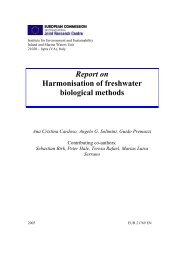Lakes and Watercourses
Lakes and Watercourses
Lakes and Watercourses
You also want an ePaper? Increase the reach of your titles
YUMPU automatically turns print PDFs into web optimized ePapers that Google loves.
TABLE 45.<br />
CURRENT CONDITIONS: fish, watercourses<br />
Proportion of<br />
Class Description No. of species 1 Biomass 2 Number 2 salmonids 3<br />
1 Very high number of species, etc ≥ 5 ≥ 2200 ≥ 222 1.00<br />
2 High number of species, etc 3 – 4 640 – 2200 64 – 222 0.90 – 1.00<br />
3 Moderate number of species, etc 2 260 – 640 23 – 64 0.73 – 0.90<br />
4 Low number of species, etc 1 95 – 260 6 – 23 0.16 – 0.73<br />
5 Very low number of species, etc 0 < 95 < 6 < 0.16<br />
Class Description Salmonid reproduction 3<br />
1 Very high salmonid reproduction 1.00<br />
2 High salmonid reproduction 0.67 – 1.00<br />
3 Moderately salmonid reproduction 0.50 – 0.67<br />
4 Low salmonid reproduction 0.33 – 0.50<br />
5 Very low salmonid reproduction < 0.33<br />
Class Description Overall index 4<br />
1 Very low overall index < 2.0<br />
2 Low overall index 2.0 – 2.5<br />
3 Moderately high overall index 2.5 – 3.6<br />
4 High overall index 3.6 – 4.0<br />
5 Very high overall index > 4.0<br />
1 Only fish species native to Sweden are included (see list of species in Appendix 3).<br />
2 Biomass <strong>and</strong> number are expressed per 100 m 2 .<br />
3 At localities where salmonids occur (char, grayling, trout or salmon), a calculation of the number<br />
of these four species having yearlings (recruitment) is ascertained. The number of breeding species<br />
is divided by the number of salmonid species.<br />
4 Calculated as the mean of the class figures for all parameters included.<br />
Class 3 represents average conditions for fish communities in Swedish<br />
lakes (see above).<br />
As with lakes, the class boundaries of the individual parameters <strong>and</strong> of<br />
the overall assessment for watercourses are based on statistical distributions<br />
of existing data on fish fauna in Swedish lakes <strong>and</strong> watercourses.<br />
With a few isolated exceptions, the 95th, 75th, 25th <strong>and</strong> 5th percentiles<br />
have been used as class boundaries. In most cases, this means that 50 per<br />
cent of existing data will fall within class 3.<br />
74















![Accommodation booking form [PDF]](https://img.yumpu.com/39471785/1/184x260/accommodation-booking-form-pdf.jpg?quality=85)

